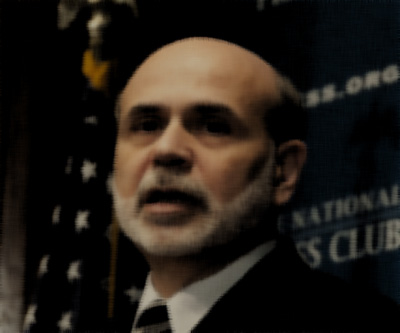Bernanke, bullion, bathos and Bill Gross

After opening Thursday at $1,634.20 an ounce August gold contracts had fallen almost 3% by lunch time, crashing through the psychologically important $1,600 an ounce level to trade at $1,587.50.
After a few very quiet trading days volumes in the three month contract surged on Thursday with the yellow metal falling more than $50 an ounce in the space of a couple of hours.
Investors were reacting to Federal Reserve Chairman, Ben Bernanke’s testimony to Congress which vaguely outlined that the Fed was prepared to provide further easing to boost a US economy that seems to have run out of steam and which is vulnerable to new shocks from Europe.
Although Wall Street welcomed the comments with the Dow enjoying a second day of strong gains, Bernanke’s statements were clearly not enough for gold bugs who have been waiting for an indication of the resumption of quantitative easing programs which boost the attraction of gold as a safe haven. Usually bold moves by the Fed encourage investment in gold as it raises inflationary pressures on the US greenback.
CNBC spoke to Pierpoint economist Stephan Stanley who summed up the mood: “Boy, that was anti-climactic. There was absolutely nothing in terms of a policy signal…no different than what he might have said at any point over the last few years.”
Bill Gross, co-CEO of the world’s largest asset manager Pimco, interpreted the comments by Bernanke and vice-chair Janet Yellen on Twitter and he now sees a 60% chance of another round of quantitative easing.
Gross’s bet on QE3 is huge – his holdings of US mortgage debt, the largest percentage of purchases under QE3, make up more than half his $250 billion Total Return fund.
There are those that believe the declines in bullion are only temporary – Jeff Currie, head of commodity research at Goldman Sachs, has re-iterated his forecast that gold will reach $1,840 by the end of the year. “Gold remains the currency of last resort, the case for higher gold prices remains intact,’ Currie told Bloomberg yesterday.
More News
{{ commodity.name }}
{{ post.title }}
{{ post.date }}

2 Comments
Alberto Enrique
Estoy de acuerdo con 2ndOrion, respaldo sus palabras. Hay mucho dinero sin respaldo, mucho papel en circulación, y las economías estos países que juegan con los papeles son las que están en riego.
Ellos enviaran muchos mensajes a la prensa para que la gente venda oro y ellos lo comprara. Hoy día con tanta información, como es que se ha cambiado lo que nos enseñaron de jóvenes, es decir cada dolar o Euro o Rupia, debe estar respaldada por una cantidad de oro en la bodegas de un Banco para que la moneda tenga un sustento real.
Si el pais comienza a fabricar billetes(papel) sin el respaldo, que es lo que han estado haciendo, lo que pasa es que engañan a los paises más chicos o sin información.
Hoy debe haber más transparencia en los mercados como eso no le conviene a muchos bancos nos dan información algo distorcionada, para que vendamos el Oro.
El Perú un pais muy prospero en la epoca de los Incas (Machupichu) guardo sus reservas en ORO y ALIMENTOS ( en ambientes cerrados que duraban tiempo), tal vez hoy nos están dando una lección de Economia Andina…. tan simple….o no puede ser
2ndOrion
If the price goes down for gold and the like, it will give those that want it a bargain. The world money situation has not gotten better -it has only gotten worse, and obviously will continue to do so. The more money in circulation – without collateral backing – the higher it will eventually go – likewise all supplies for doing things -with it. -So, the cost of doing business also rises accordingly.